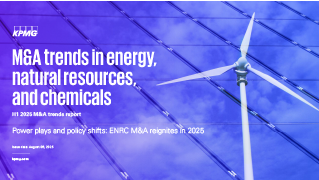Power, politics, and portfolio plays
The ENRC sector experienced significant activity during the first half of 2025, driven largely by shifting political landscapes and evolving energy demands. Renewables saw substantial growth in H1’25, marked by a 10.5 percent increase in deal volume and a remarkable 384.6 percent rise in deal value compared to H2’24. This surge is driven by AI-fueled electricity demand, with US data centers projected to account for 8.6 percent of total electricity demand by 2035. States such as Virginia, Texas, Ohio, and Georgia are emerging as critical hubs for renewable energy access. Amid uncertain macroeconomic conditions, companies are focusing on strategic capital discipline for immediate profitability and long-term growth opportunities. With the return of the Trump administration, oil and gas (O&G) firms gained regulatory clarity, motivating increased dealmaking despite uncertainties.
The administration's macroeconomic focus on growth has broadened traditional energy investment avenues. The broad reversal of clean energy subsidies is projected to significantly slow renewable installations and deter investment. However, acquisitions in solar and battery storage have continued robustly, with deal value skyrocketing. This compensates for federal policy uncertainties as companies seek to leverage AI demands and align portfolios with state-level decarbonization efforts.
Rumors of a possible Shell–BP merger highlight the potential for major strategic realignment among global players, addressing changing valuations and investment priorities. This potential merger would likely reflect broader tensions in balancing renewable investments and traditional O&G assets. Despite challenges, investments in solar and battery storage persisted, focusing on economically viable projects that reduce reliance on government incentives.
Advancements in AI and energy needs of data centers drove vertical integration within power and utilities, reflecting the strategic importance of technology. The strategic acquisition of Encino Acquisition Partners by EOG Resources exemplifies this trend,1 as it consolidates overlapping gas basins and leverages operational synergies to integrate back-office operations. This highlights the sector’s focus on efficiency and consolidation alongside innovation. As strategic priorities across subsectors recalibrated, M&A activity rebounded, marking a notable increase in deal value up from a cautious 2024.2
Across the board, M&A activity has rebounded, with total deal value in H1’25 rising 42.2 percent compared to H2’24, despite a 10.7 percent decline in volume. Strategic buyers led the charge, accounting for nearly 70 percent of deal volume and 78 percent of deal value. This shift reflects a preference for smaller adjacent or ancillary bets in methane monitoring, for example, or service businesses tied to infrastructure, providing strategic advantages without committing to large-scale projects. The sector’s resilience is evident in the diversity of deals—from billion-dollar oil basin consolidations to targeted acquisitions in battery storage and advanced materials. This report dissects the data, trends, and strategic implications shaping the ENRC M&A landscape and offers a forward-looking view into H2’25.


















